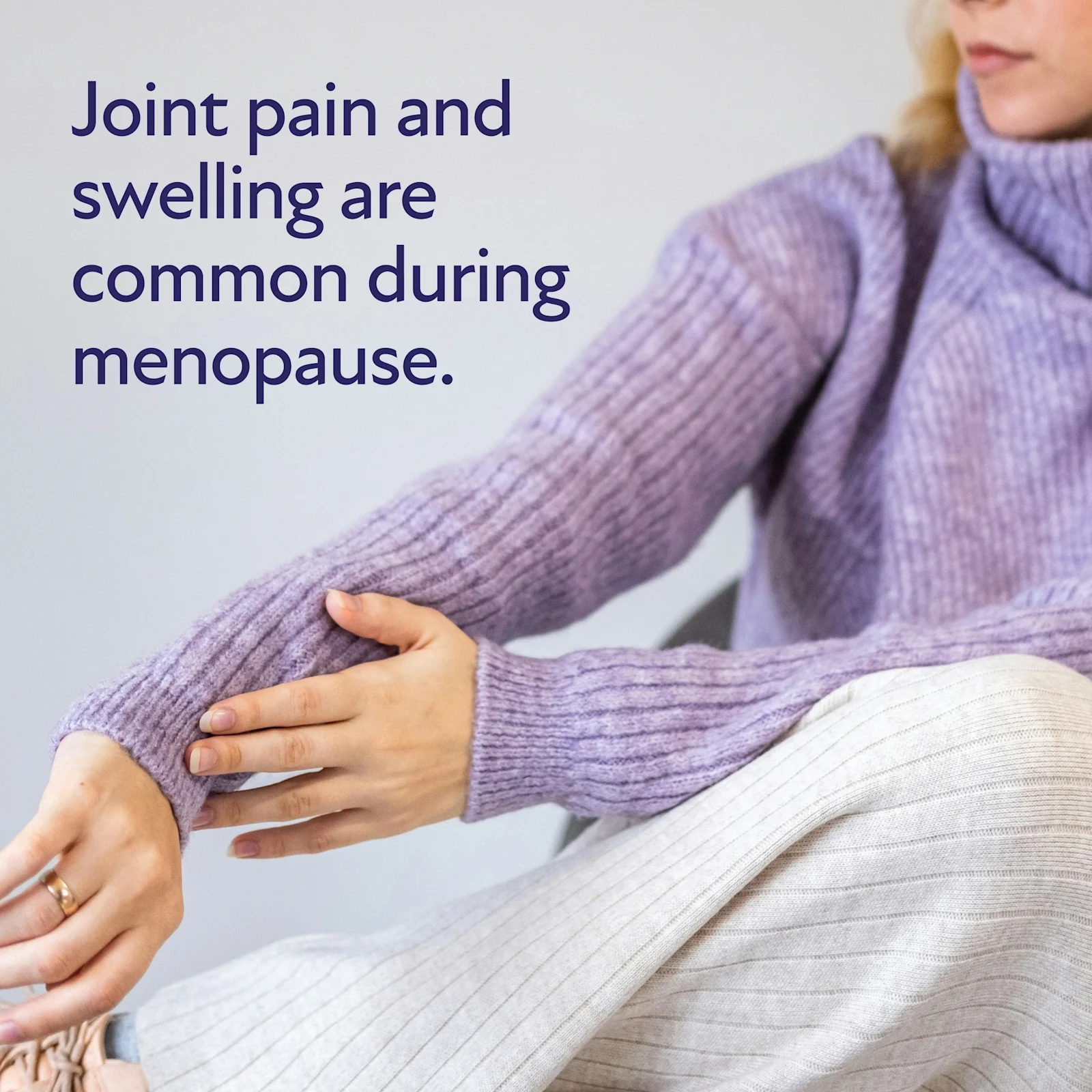Joint pain is a common complaint, often stemming from past injuries, medication side effects, or the natural aging process. However, as menopause approaches, these aches can become more frequent and pronounced. Research shows that over half of women going through the menopausal transition experience joint pain, medically termed arthralgia.(1)
The escalation in joint pain during menopause is linked to the decline in estrogen levels that occurs at this time. Estrogen is vital for protecting joints and mitigating inflammation. A decrease in estrogen may cause inflammation, elevating the risk of developing osteoarthritis or osteoporosis, conditions that often result in joint discomfort. Other physiological changes, such as decreased muscle mass, reduced physical activity, and body weight fluctuations, can also exacerbate joint pain.
While joint pain in menopause does not automatically suggest arthritis, it’s crucial to understand when to seek further medical consultation. Thankfully, a variety of treatment options exist to manage different types of pain, allowing individuals to find relief and enhance their quality of life.
What causes menopause joint pain?
Research suggests the following factors may increase the risk of joint pain during menopause:
Hormonal Fluctuations
Experts believe estrogen deficiency may be linked to the onset of musculoskeletal aches and pains during menopause. It affects the health of cartilage and the connective tissue in joints and influences bone turnover, which is the natural process of bone replacement in the body. Estrogen can thus contribute to inflammation and pain.(2)
Bone Loss and Osteoporosis
The decline in estrogen levels during menopause may lead to reduced bone density, which then increases the risk of osteoporosis. This condition, marked by diminished bone mass, causes bones to become weak and brittle, making individuals more prone to pain and fractures.(2)
Decreased Muscle Mass
Menopause can lead to sarcopenia, a decline in muscle mass and strength, which makes joints more susceptible to pain and injury. One contributing factor is the low levels of DHEA, a prohormone that converts into sex steroids like androgens and estrogen. DHEA plays a crucial role in maintaining muscle mass and reducing fat mass.(3)
Circulating DHEA levels naturally decline with age, especially during menopause. The sharp drop between the perimenopausal and postmenopausal stages can result in muscle loss and joint pain.
Additionally, an imbalance between muscle protein synthesis and breakdown, increased oxidative stress and inflammation, decreased physical activity, and changes in body weight can all exacerbate muscle loss and joint pain.(3)
Autoimmune Conditions
Hormonal fluctuations during menopause may be linked to an increased risk of autoimmune diseases, such as rheumatoid arthritis. While not all women experience this, some may be more susceptible due to risk factors like environmental changes or genetic predispositions. Women who already have these conditions may see an aggravation of their symptoms during this transition.(4)
Lifestyle Factors
Many women might become less active during this phase, increasing stiffness and joint pain. A lack of physical activity creates a vicious cycle where the more a person’s joints hurt, the less likely they are to engage in physical activities, further exacerbating the problem. Other lifestyle factors, such as poor diet, inadequate hydration, and high stress levels, can contribute to joint pain too.

Recognizing the Symptoms of Menopause Joint Pain
Menopausal joint pain may be more intense in the morning due to overnight inactivity but might improve as the day progresses and movement increases.
Symptoms of menopausal joint pain may include:
Stiffness
Swelling
Shooting pains
Burning sensation after physical activity
Decreased range of motion
Cracking or popping sounds when joints move
Associated muscle and back pain
Joint pain can significantly impact overall quality of life. It may cause feelings of anxiety and depression among women, affecting their emotional health. Sleep troubles are also common, as finding a comfortable sleep position can be challenging.
Managing Menopause Joint Pain
Implementing these strategies can help alleviate joint pain:
Exercise
Exercise might seem counterintuitive, but studies have shown it’s essential for easing joint discomfort. Physical activity improves mental, heart, and bone health. It’s best to engage in low-impact activities like swimming, cycling, or walking, as they can prevent joints from becoming stiff and painful.(5)
Exercises that boost joint flexibility and muscle strength are also beneficial. Yoga and other joint mobility exercises enhance flexibility and promote the circulation of synovial fluid, which is essential for joint health.
Consulting a healthcare provider is essential if pain persists despite an active and healthy lifestyle. They can recommend HRT or other medications to manage joint pain and improve overall health.
Weight Management
Keeping a healthy weight is essential for joint pain management. Reducing body weight alleviates the burden on joints, improving joint-related symptoms. Studies indicate that a reduction of just 10 pounds can cut the advancement of knee arthritis by 50%.(6)
Heat and Cold Therapy
Applying warmth to achy joints can provide temporary relief from discomfort. Options such as heating pads, hot water bottles, warm compresses, or a soothing bath can be effective. Conversely, using an ice pack can effectively reduce swelling and ease pain for joints that are inflamed and swollen.
Over-the-Counter Pain Relief
There are various over-the-counter options available that can alleviate symptoms and reduce inflammation:
Pain relievers like acetaminophen
Anti-inflammatory gel like diclofenac
Non-steroidal anti-inflammatory drugs (NSAIDs) like ibuprofen or naproxen
It’s important to consult a physician before starting any medication, as these treatments may cause side effects and are not suitable for everyone.
Lifestyle Modifications
Eating a healthy diet rich in essential nutrients can help mitigate the side effects of menopause, including joint pain. The following are other lifestyle habits that may help:
Boosting intake of proteins to maintain muscle mass, which is essential for bone support during menopause
Quitting smoking to lower the risks of cardiovascular diseases and bone loss and enhance bone healing, thereby reducing joint pain and stiffness
Prioritizing sufficient sleep, which helps in managing pain perception
Adopting stress management techniques to alleviate pain and improve overall well-being during menopause
Complementary Therapies for Menopause Joint Pain
Exploring therapies such as acupuncture and massage can significantly aid in managing symptoms associated with menopausal joint pain.
Acupuncture involves the precise insertion of fine needles into designated points on the body, aiming to stimulate nerves, muscles, and connective tissue. This stimulation can enhance the body's natural pain-relieving mechanisms and improve circulation, effectively reducing pain and enhancing mobility.
Similarly, massage therapy helps relax tense muscles, increase circulation, and promote overall well-being. It can also contribute to alleviating the pain and stiffness often experienced during menopause.
Individuals should consult with a healthcare professional before initiating these therapies to ensure they align with their personal health needs and to avoid potential complications.
Hormone Replacement Therapy (HRT) and Menopause Joint Pain
HRT is widely regarded as the most effective method for managing symptoms of menopause, significantly enhancing quality of life, energy levels, and sleep quality. Research has demonstrated that balanced estrogen levels can reduce stiffness in muscles, tendons, and ligaments, thus improving joint function and decreasing the likelihood of injuries.(7,8)
Estrogen's anti-inflammatory properties play a crucial role in this relief by reducing the inflammation that often contributes to joint pain. Moreover, estrogen is thought to help maintain the health of the joint lining, which can lessen pain and discomfort. HRT also supports bone density, helping to prevent osteoporosis — a condition that weakens bones and can exacerbate joint pain.(7,8)
When to See a Doctor for Menopausal Joint Pain
It’s important for anyone experiencing joint pain during menopause to seek medical attention if the pain persists or worsens or if new, concerning symptoms arise. Consulting a healthcare provider is advisable if self-care strategies and home remedies fail to provide relief.
A doctor can diagnose the underlying causes of the pain and recommend appropriate treatments or interventions. Early diagnosis can help manage symptoms effectively and prevent further complications. Doctors can also create a personalized treatment plan that may include lifestyle adjustments, medication, or therapy specific to the individual's needs.
Experiencing joint or muscle pain during menopause? Discover if HRT is right for you.
If you’ve entered the menopause transition and are struggling with joint pain, you don’t have to suffer in silence. Take our brief menopause quiz to see if you’re an eligible candidate for HRT. Get started with Winona to take the first step toward feeling better.
